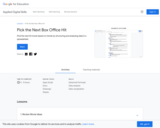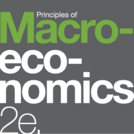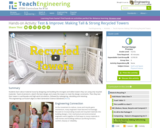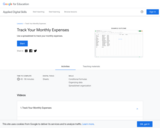
This lesson plan helps students distinguish between earned and unearned income by identifying methods for getting money.
- Subject:
- Mathematics
- Material Type:
- Lesson Plan
- Provider:
- EconEdLink
- Date Added:
- 08/07/2023

This lesson plan helps students distinguish between earned and unearned income by identifying methods for getting money.

How would you deal with the national budget if you were the President of the United States? What if there was a national emergency? This site includes a budget simulation on the computer that allows students to make real budget decisions. What to cut? What to increase? The site has a great exercise in economic decision making.

Using their knowledge of the phases of matter, the scientific method, and polymers, student teams work as if they are chemical engineers to optimize the formula for slime. Hired by the fictional company, Slime Productions, students are challenged to modify the chemical composition of the basic formula for slime to maximize its "bounce factor."

The difference between an architect and an engineer is sometimes confusing because their roles in building design can be similar. Students experience a bit of both professions by following a set of requirements and meeting given constraints as they create a model parking garage. They experience the engineering design process first-hand as they design, build and test their models. They draw a blueprint for their design, select the construction materials and budget their expenditures. They also test their structures for strength and find their maximum loads.

Find the next hit movie based on trends by structuring and analyzing data in a spreadsheet. Time to complete: 6-9 hours

Principles of Macroeconomics 2e covers the scope and sequence of most introductory economics courses. The text includes many current examples, which are handled in a politically equitable way. The outcome is a balanced approach to the theory and application of economics concepts. The second edition has been thoroughly revised to increase clarity, update data and current event impacts, and incorporate the feedback from many reviewers and adopters. Changes made in Principles of Macroeconomics 2e are described in the preface and the transition guide to help instructors transition to the second edition. The first edition of Principles of Macroeconomics by OpenStax is available in web view here.


By the end of this section, you will be able to:
Describe how the federal government can use discretionary fiscal policy to stabilize the economy
Identify examples of automatic stabilizers
Understand how a government can use standardized employment budget to identify automatic stabilizers

Students learn about material reuse by designing and building the strongest and tallest towers they can, using only recycled materials. They follow design constraints and build their towers to withstand earthquake and high wind simulations.

In this activity, students revisit the Pop Rockets activity from Lesson 3. This time, however, the design of their pop-rockets will be limited by budgets and supplies. They will get a feel for the limitations of a real engineering project as well as an opportunity to redesign and retest their rockets.

Students learn about the major factors that comprise the design and construction cost of a modern bridge. Before a bridge design is completed, engineers provide overall cost estimates for construction of the bridge. Students learn about the components that go into estimating the total cost, including expenses for site investigation, design, materials, equipment, labor and construction oversight, as well as the trade-off between a design and its cost.

This article describes the energy that radiates from the sun, the concept of albedo, Earth's radiation budget, and the effect of decreasing albedo on Earth's climate.

A “Standard” Personal Finance Curriculum is designed as a high school personal finance course. It is divided into seven units that address the six National Standards for Financial Literacy and a standard on decisionmaking, respectively. Each unit includes a description, talking points, and links to recommended resources for teaching the given standard, along with a selection of supplemental resources. The talking points are introductory comments and information about the content for each unit. Recommended resources include lessons, videos, and online modules. Thus, the curriculum is designed with flexibility for teachers to select the individual resources that best meet the needs of their classes. The curriculum also includes a glossary of terms and a matrix that aligns all of the recommended and supplemental resources with the national standards.

Use a spreadsheet to track your monthly expenses. Time to complete: 45-90 minutes

Have you ever seen an item that you wanted on sale for 15% of its original price? Have you tried to figure out what the sale price would be? Using this interactive lesson from T.V. 411, you can learn to calculate discounts with percentages.

In this video segment from Cyberchase, Harry must adjust his dinner budget after his cousin, Harry, unexpectedly decides to join him on his date

Students learn about budgets and then use a budget to decide what food to buy for an imaginary party.

All it takes is one day to start making an impact on your finances. Learn ways to save money on your monthly household bills. [4:43]
Khan Academy learning modules include a Community space where users can ask questions and seek help from community members. Educators should consult with their Technology administrators to determine the use of Khan Academy learning modules in their classroom. Please review materials from external sites before sharing with students.

In reading and discussing Lyddie, by Katherine Paterson, students examine basic economic concepts and explore the growth of labor unions and the role of government in a market economy.